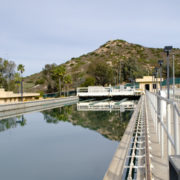Lake Poway’s water level is lower today, but it isn’t due to the current heatwave. The lake is being temporarily reduced to complete a planned maintenance project to replace a transducer.
Lake Poway serves as the City of Poway’s main water storage reservoir, with a capacity to hold more than one billion gallons of water. A transducer measures the lake’s water level and remotely sends data to the city.
The city typically takes advantage of lower summer lake levels every year as part of a process to maintain the water quality and for maintenance. Water drawn down from Lake Poway is sent to the Lester J. Berglund Water Treatment Plant for treatment. Replacement water is added back in from supplies the city purchases from the San Diego County Water Authority.
Drinking water is not being discarded. Instead, the City of Poway is moving drinking water into the delivery system for treatment, and holding back on replenishing the lake until the maintenance project is complete.
The work creates a bonus for San Diego County’s avid fishing fans.
“It’s not unusual for the water level to be down in the lake this time of year,” said Allie Margie, Recreation Supervisor at Lake Poway. “Our night fishing and catfish restocking schedule aren’t affected – and with less water and more fish in the lake, your chances of making a catch might be better than ever.”
Three billion gallons of drinking water safely treated annually

Lake Poway treats three billion gallons of drinking water annually. Photo: City of Poway
Poway operates a modern water treatment and distribution system. Lake Poway serves as a storage reservoir for imported water from both the Colorado River and Northern California.
Water flows through the Berglund Water Treatment Plant, where approximately three billion gallons of drinking water are treated every year for the citizens of Poway. Once treated, the drinking water enters a system of pipes, pump stations, reservoirs for delivery to customer’s homes and businesses.
Did you know?
- The City of Poway maintains about 294 miles of water pipe.
- There are approximately 2,345 fire hydrants throughout the city.
- There are over 5,044 valves in the water system.
- Employees working in the water system are required to be certified by the State of California to work in a water system.





